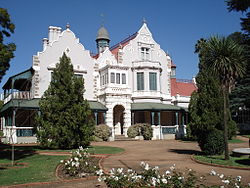History
Built in 1886 by the prosperous Pretoria businessman George Jesse Heys, it was named after the famous Melrose Abbey in Scotland. Melrose House gained fame during the Second Boer War (1899–1902) when Lord Roberts requisitioned it as the headquarters for the British forces after Pretoria was invaded in June 1900. For more than 18 months, instructions for the British forces in the field were issued from here. The use of the house as a military headquarters ended when the Treaty of Vereeniging, which ended the war, was signed there on 31 May 1902.
The Pretoria City Council purchased the house and its contents in 1967 for R300,000 for restoration, culminating in State President of South Africa Charles Robberts Swart opening it as a museum and declaring it a national heritage site on May 17, 1971.
This page is based on this
Wikipedia article Text is available under the
CC BY-SA 4.0 license; additional terms may apply.
Images, videos and audio are available under their respective licenses.












